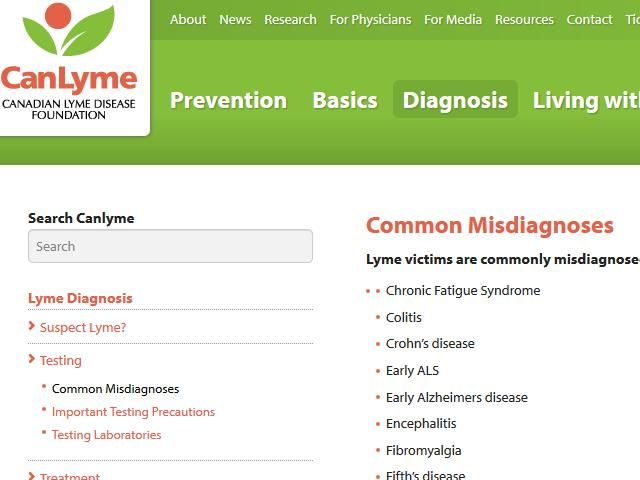LYME SCI: Help! I’ve been bitten by a tick. Now what?Tick season is in full-swing. How do I know that? I wake up practically every day to another text or email from a friend or relative saying they found a tick on themselves, a loved one or a pet.
Last week, I got a desperate call from a relative whose son found a tick embedded in his skin after a camping trip. Both my cousin and her son are well aware of my daughter’s missed diagnosis and years’ long battle with Lyme and co-infections. Needless to say, they were in a panic. More about this later… Of course the best thing is to prevent tick bites in the first place, but life happens and that’s probably why you’re reading this. Here’s my advice: <more here> Is It RA or Lyme Disease?
Rheumatoid arthritis (RA) and Lyme disease are very different conditions that need separate treatments. Still, they share symptoms. If you have them, you may wonder which condition you have.
What’s RA?It's a long-term disease that leads to joint inflammation. It affects the soft tissues surrounding joints. It can also affect other organs. If you have this, your body mistakenly attacks healthy tissue. You can get it at any point in your life. It’s most commonly found in middle age, and it affects nearly 3 times as many women as men. Symptoms can include:
Some people call Lyme disease “the great imitator,” because it can be confused with a number of other conditions, including:
<More Info Here> |
Common Misdiagnoses of Lyme victims are commonly misdiagnosed with other illnesses, such as:
<Learn more here> Chronic Lyme DiseaseTHE CHRONIC LYME DISEASE Controversy:
Lyme disease (CLD) is a poorly defined term that describes the attribution of various atypical syndromes to protracted Borrelia burgdorferi infection. These syndromes are atypical for Lyme disease in their lack of the objective clinical abnormalities that are well-recognized in Lyme disease and, in many cases, the absence of serologic evidence of Lyme disease as well as the absence of plausible exposure to the infection. The syndromes usually diagnosed as CLD include chronic pain, fatigue, neurocognitive, and behavioral symptoms, as well as various alternative medical diagnoses—most commonly neurologic and rheumatologic diseases. Perhaps the most recognized and contentious facet of this debate is whether it is effective, appropriate, or even acceptable to treat patients with protracted antibiotic courses based on a clinical diagnosis of CLD. <Read More Here> |
Lyme Disease: Missed and MisdiagnosedWe are experiencing an absolute epidemic of Lyme disease in the United States. Making things even worse is that many physicians don’t understand or deny that Lyme is so serious. It’s a tragedy.
Lyme disease was so-named because it was “discovered” in Lyme, Connecticut. It is most common in New England, up and down the east coast, and the Midwest. But other individuals with Lyme have lived in Texas, South America, Europe, and Asia. When we speak of Lyme disease, we mean not only Borrelia, the name of the Lyme organism itself, but many co-infections that infected individuals also have. These co-infections include Babesia, Bartonella, Brucella, Chlamydia, Ehrlichia, Mycoplasma, Rocky Mountain Spotted Fever, Tularemia, and a variety of viruses. Lyme is contracted by being bitten from a tiny deer tick, a tick so small that you can barely see it. Some individuals who are bitten by the deer tick may find the tick on their body or see a “bulls-eye” rash, but most people don’t find the tick and don’t have a rash. Infections with Borrelia and its co-infections brethren typically have a gradual onset, often with a flu-like illness. People can have unexplained fevers or hot and cold spells. Memory, planning, reading, brain processing, and judgment may be impaired. In severe cases it can literally become impossible to string together words to make a sentence. Fatigue and exhaustion are common. Sleep problems—often severe—are almost invariably present. Headaches are common. Infected people are often moody and irritable. Individuals may have gastrointestinal disturbances. Sensitivity to sounds is increased, so that people can feel assaulted by the world around them. Light sensitivity is common. Bell’s palsy can occur—a mild or not so mild—one-sided facial drooping. In fact, Bell’s palsy is always due to Lyme disease until proven otherwise. Infected individuals can have erratic blood pressure changes or life-threatening changes in heart electrical rhythms. Our experience, and that of others who are very familiar with Lyme, is that chronic fatigue syndrome and fibromyalgia are often caused by Lyme and co-infections. <More Here> |





